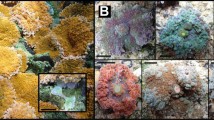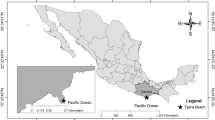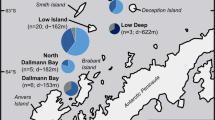Abstract
Reproductive strategies, whether sexual or asexual, are critical aspects of introduction success and spread for non-indigenous species. The Western Pacific Diadumene lineata (Verrill, 1869), the world’s most widely distributed sea anemone due to numerous introductions, is believed to reproduce only by asexual means outside of its home range. Over the past 100 years, no populations with both males and females have been reported to co-occur outside of its native Japan. We report the first discovery of sympatric reproductive male (sperm-bearing) and female (egg-bearing) D. lineata in Coos Bay, Oregon, USA, confirmed by histological analysis. Given that only single gender introduced populations have been reported elsewhere, the presence of both genders in this US Pacific Northwest bay may be linked to high and continuous propagule pressure resulting from a history of intensive lumber and timber shipping directly between Japan and Coos Bay. Novel modern-day introductions of this species, in which reproductive traits previously only associated with native populations are manifested, could influence the future invasion success and spread of this species.

Photograph by Nancy Treneman


Similar content being viewed by others
References
Barrett SCH (2011) Why reproductive systems matter for the invasion biology of plants. In: Richardson D (ed) Fifty years of invasion ecology: the legacy of Charles Elton. Wiley-Blackwell, Oxford, pp 195–210
Carlton JT, Geller JB (1993) Ecological roulette: the global transport of nonindigenous marine organisms. Science 261:78–82
Castro S, Castro M, Ferrero V, Costa J, Tavares D, Navarro L, Loureiro J (2016) Invasion fosters change: independent evolutionary shifts in reproductive traits after Oxalis pes-caprae L. introduction. Front Plant Sci 7:874. https://doi.org/10.3389/fpls.2016.00874
Cutress CE (1949) The Oregon shore-anemones (Anthozoa). Master of Science thesis, Oregon State College, Corvallis
Dunn DF (1982) Sexual reproduction of two intertidal sea anemones (Coelenterata: Actiniaria) in Malaysia. Biotropica 14:262–271
Flenniken MM (2017) Understanding the invasion success and spread of the globally introduced marine invertebrate, Diadumene lineata. Ph.D. dissertation, Ecology and Evolution, Stony Brook University
Fofonoff PW, Ruiz GM, Steves B, Simkanin C, Carlton JT (2018) National exotic marine and estuarine species information system. http://invasions.si.edu/nemesis/. Accessed 16 Jan 2018
Fukui Y (1986) Catch tentacles in the sea anemone Haliplanella luciae. Role as organs of social behavior. Mar Biol 91:245–251
Fukui Y (1991) Embryonic and larval development of the sea anemone Haliplanella lineata from Japan. Hydrobiologia 216(217):137–142
Fukui Y (1995) Seasonal change in testicular structure of the sea anemone Haliplanella lineata (Coelenterata: Actinaria). Invertebr Reprod Dev 27:197–204
Gadelha JR, Morgado F, Soares AMVM (2012) Histological and structural analysis of Actinia equina L. (Cnidaria: Anthozoa). Microsc Microanal 18:61–62
Gadelha JR, Morgado F, Soares AMVM (2013) Histology and histochemistry of sea anemones in environmental contamination studies. Microsc Microanal 19:57–58
Hancock ZB, Goeke JA, Wicksten MK (2017) A sea anemone of many names: a review of the taxonomy and distribution of the invasive actinian Diadumene lineata (Diadumenidae), with records of its reappearance on the Texas coast. ZooKeys 706:1–15
Hargitt CW (1914) The anthozoa of the Woods Hole region. Bull U S Bureau Fish 32:223–245
Hieb K (1977) A population study of the sea anemone Haliplanella luciae in Bodega Harbor. Student Report, Biology of Marine Invertebrates Course, University of California Bodega Marine Laboratory, Bodega Bay CA, pp 1–13
Johnson LL, Shick JM (1977) Effects of fluctuating temperature and immersion on asexual reproduction in the intertidal sea anemone Haliplanella luciae (Verrill) in laboratory culture. J Exp Mar Biol Ecol 28:141–149
Kaluza P, Kolzsch A, Gastner MT, Blasius B (2010) The complex network of global cargo ship movements. J R Soc Interface 7:1093–1103
Krueger-Hadfield SA, Kollars NM, Byers JE, Greig TW, Hammann M, Murray DC, Murren CJ, Strand AE, Terada R, Weinberger F, Sotka EE (2016) Invasion of novel habitats uncouples haplo-diplontic life cycles. Mol Ecol 25:3801–3816
McManus MG, Place AR, Zamer WE (1997) Physiological variation among clonal genotypes in the sea anemone Haliplanella lineata: growth and biochemical content. Biol Bull 192:426–443
Meek MH, Wintzer AP, Shepard N, Bernie M (2013) Genetic diversity and reproductive mode in two non-native hydromedusae, Maeotias marginata and Moerisia sp., in the upper San Francisco Estuary. Calif Biol Invasions 15:199–212
Minasian LL (1982) The relationship of size and biomass to fission rate in a clone of the sea anemone, Haliplanella luciae (Verrill). J Exp Mar Biol Ecol 58:151–162
Mire P, Venable S (1999) Programmed cell death during longitudinal fission in a sea anemone. Invertebr Biol 118:319–331
Oregon Blue Book (2016) Oregon history: rapid developments. http://www.bluebook.state.or.us/cultural/history/history27.htm. Accessed 1 Nov 2016
Pannell JR, Auld JR, Brandvain Y, Burd M, Busch JW, Cheptou PO, Conner JK, Goldberg EE, Grant AG, Grossenbacher DL, Hovick SM, Igic B, Kalisz S, Petanidou T, Randle AM, de Casas RR, Pauw A, Vamosi JC, Winn AA (2015) The scope of Baker’s law. New Phytol 208:656–667
Roman J (2006) Diluting the founder effect: cryptic invasions expand a marine invader’s range. Proc R Soc B 273:2453–2459
Seebens H, Blackburn TM, Dyer EE, Genovesi P, Hulme PE, Jeschke J, Pagad S, Pysek P, Winter M, Arianoutsou M, Bacher S, Blasius B, Brundu G, Capinha C, Celesti-Grapow L, Dawson W, Dullinger S, Fuentes N, Jager H, Kartesz J, Kenis M, Kreft H, Kuhn I, Lenzner B, Liebhold A, Mosena A, Moser D, Nishino M, Pearman D, Pergl J, Rabitsch W, Rojas-Sandoval J, Roques A, Rorke S, Rossinelli S, Roy HE, Scalera R, Schindler S, Stajerova K, Tokarska-Guzik B, van Kleunen M, Walker K, Weigelt P, Yamanaka T, Essl F (2017) No saturation in the accumulation of alien species worldwide. Nat Commun 8:14435
Shick JM (1976) Ecological physiology and genetics of the colonizing actinian Haliplanella luciae. In: Mackie GO (ed) Coelenterate ecology and behavior. Plenum Press, New York, pp 137–146
Shick JM (1991) A functional biology of sea anemones. Functional biology series. Springer, Dordrecht
Shick JM, Lamb AN (1977) Asexual reproduction and genetic population structure in the colonizing sea anemone Haliplanella luciae. Biol Bull 153:604–617
Ting JH, Geller JB (2000) Clonal diversity in introduced populations of an Asian sea anemone in North America. Biol Invasions 2:23–32
Uchida T (1932) Occurrence in Japan of Diadumene luciae, a remarkable actinian of rapid dispersal. J Fac Sci Hokkaido Imp Univ (6) Zool 2:69–82
Wedi S, Dunn DF (1983) Gametogenesis and reproductive periodicity of the subtidal sea anemone Urticina lofotensis (Coelenterata: Actinaria) in California. Biol Bull 165:458–472
Zuljevic A, Antolic B (2000) Synchronous release of male gametes of Caulerpa taxifolia (Caulerpales, Chlorophyta) in the Mediterranean Sea. Phycologia 39:157–159
Acknowledgements
We thank the Williams College-Mystic Seaport Maritime Studies Program and the Department of Ecology and Evolution at Stony Brook University for financial support. Ali Stevens, Zara Currimjee, Anna Hopkins and Nuria Clodius contributed to field and laboratory work. We thank Nancy Treneman for providing a photograph of anemone populations in Isthmus Slough; Jonathan Geller for information on San Diego anemone populations; Glenn Lopez, Dianna Padilla, and Stephen Baines for comments on the manuscript; and Nuclea Biotechnologies for their help in processing samples.
Author information
Authors and Affiliations
Corresponding author
Additional information
Publisher's Note
Springer Nature remains neutral with regard to jurisdictional claims in published maps and institutional affiliations.
Rights and permissions
About this article
Cite this article
Newcomer, K., Flenniken, M.M. & Carlton, J.T. Home and away and home again: discovery of a native reproductive strategy of the globally invading sea anemone Diadumene lineata (Verrill, 1869) in a satellite population. Biol Invasions 21, 1491–1497 (2019). https://doi.org/10.1007/s10530-019-01940-y
Received:
Accepted:
Published:
Issue Date:
DOI: https://doi.org/10.1007/s10530-019-01940-y




